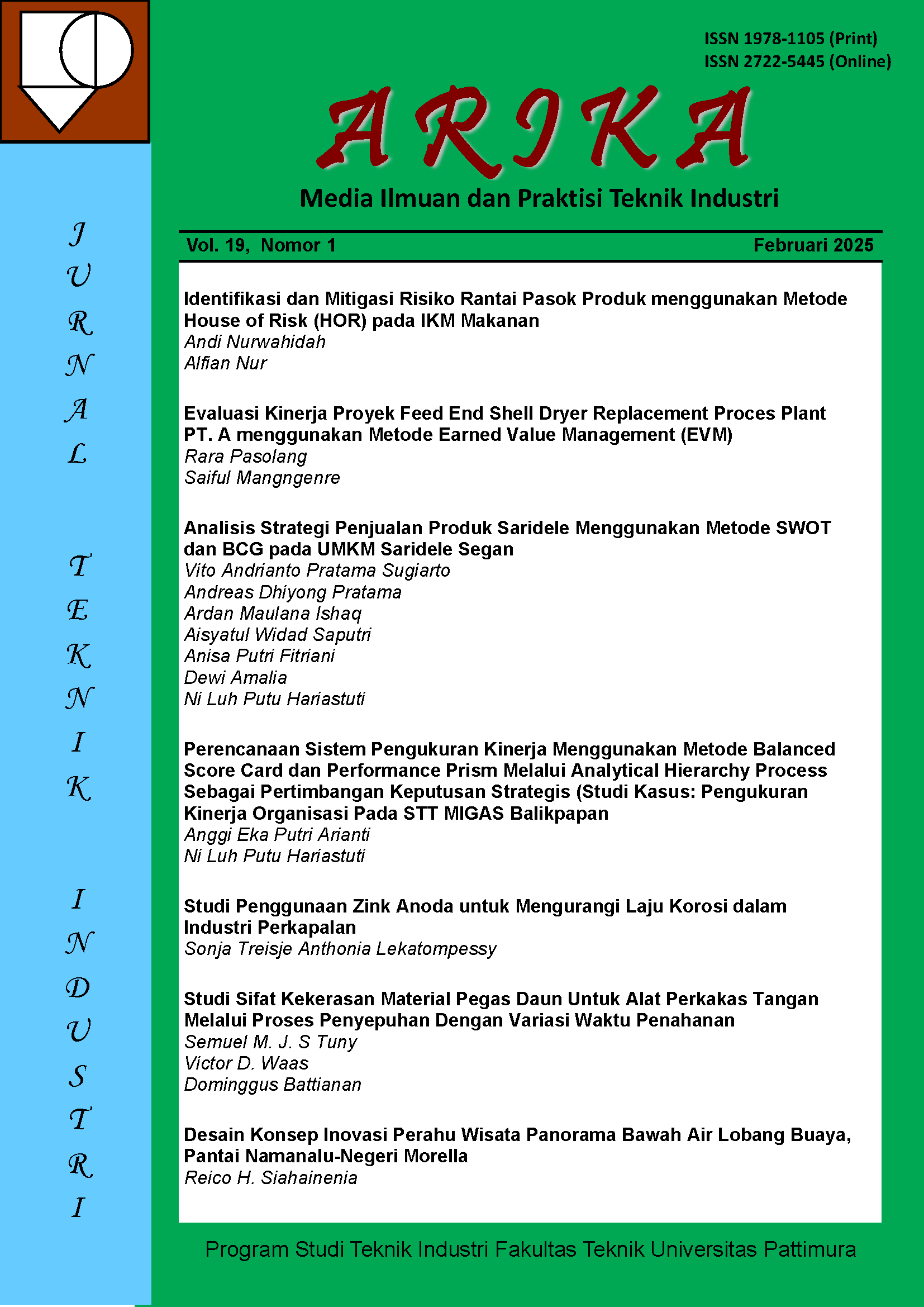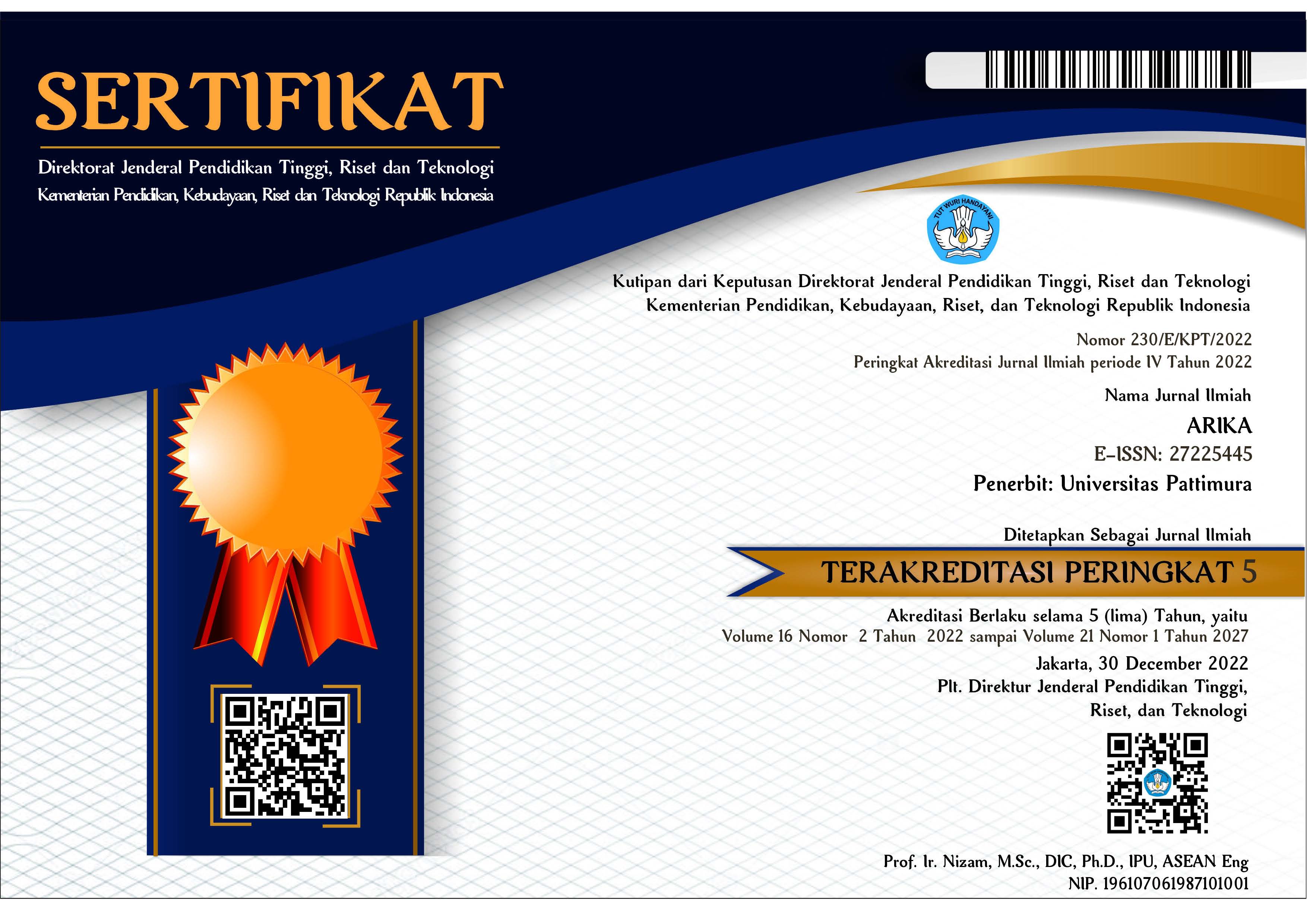Studi Sifat Kekerasan Material Pegas Daun Untuk Alat Perkakas Tangan Melalui Proses Penyepuhan Dengan Variasi Waktu Penahanan
Study of Hardness Properties of Leaf Spring Material for Hand Tools Through Plating Process with Variation of Holding Time
Abstract
A study was conducted to investigate the effect of variation in holding time during the hardening process on the hardness of leaf spring steel. Used leaf spring steel is widely utilized as raw material for the manufacturing of hand tools by blacksmiths through hardening processes. Hardening is a heat treatment method aimed at enhancing the hardness of a material. The hardening process involves heating the material to a specific temperature (austenitizing temperature), holding it for a certain period, and then rapidly cooling it. This study aims to investigate the effect of variations in austenitizing holding time, specifically 30 seconds, 40 seconds, 45 seconds, 50 seconds, and 60 seconds, on the hardness value of leaf spring steel. The leaf spring steel material is subjected to heat treatment at an austenitizing temperature of 900°C, followed by quenching in oil. Hardness testing is performed using the Hardness Rockwell B (HRB) method. The results of the study indicate that hardening can enhance the hardness properties of leaf spring steel; however, as the holding time increases, the hardness level tends to decrease. The highest average hardness value was recorded at a holding time of 45 seconds, with a hardness value of 121 HRB.
Downloads
References
Adawiyah, R., Murdjani, & Hendrawan, A. (2014). Pengaruh Perbedaan Media Pendingin Terhadap Struktur Mikro dan Kekerasan Pegas Daun dalam Proses Hardening. Jurnal POROS TEKNIK, Volume 6, No. 2, 55-102.
Al Faris, M.S., & Rasyid, A.H.A. (2023). Pengaruh Variasi Media Pendingin Terhadap Nilai Kekerasan dan Ketangguhan Baja AISI 1045 Aplikasi Poros Motor. JTM: JURNAL TEKNIK MESIN, Vol. 11, No. 03, 165-170. https://doi.org/10.26740/jtm.v11n03.p165-170
Arifin, F., & Wijianto. (2008). Pemanfaatan Pegas Daun Bekas sebagai Bahan Pengganti Mata Potong (Punch) pada Alat Bantu Produksi Massal (Press Tools). MEDIA MESIN, Vol. 9, No. 1, 20-27. https://doi.org/10.23917/mesin.v9i1.3156
ASTM E18. (2022). Standard Test Methods for Rockwell Hardness of Metallic Materials. West Conshohocken: ASTM International.
Cahyadi, R., Asiri, M.H., & Mardin. (2022). Pengaruh Hardening Terhadap Kekerasan Kekuatan Tarik pada Baja Pegas Daun Bekas untuk Pisau. Journal of Technology Procces, Vol. 1, No. 2, 33-40.
Choliq, A., & Adnyana, D.N. (2018). Optimalisasi Heat Treatment pada Proses Daur Ulang Pegas Daun Mobil untuk Pembuatan Pisau Sembelih Rumah Pemotongan Hewan. Journal of Technical Engineering: Piston, Vol. 2, No. 1, 27-37. https://doi.org/10.32493/pjte.v2i1.3225
Farhan, Bukhari, Hamdani, Yusuf, I., Zuhaimi. (2021). Pengaruh Temperatur Pemanasan (Austenisasi) Perlakuan Panas Quenching Terhadap Kekerasan dan Struktur Mikro Baja ST 60. Jurnal Mesin Sains Terapan, Vol. 5, No. 1. http://dx.doi.org/10.30811/jmst.v5i1.2135
Handoyo, Y. (2015). Pengaruh Quenching dan Tempering Pada Baja JIS Grade S45C Terhadap Sifat Mekanis dan Struktur Mikro Crankshaft. Jurnal Imiah Teknik Mesin, Vol. 3, No.2, 102-115. https://doi.org/10.33558/jitm.v3i2.350
Hardiyanti, I., Aziz, A., & Hidayat, M. (2015). Pengaruh Temperatur Austenisasi dan Waktu Tahan Terhadap Sifat Mekanik, Tebal Scale dan Struktur Mikro Pada Baja Paduan Ni-Cr-Mo. Jurnal Furnace, Vol. 1, No. 1. http://dx.doi.org/10.36055/furnace.v1i1.1672
Hartono, B. (2015). Pengerasan Baja AISI O1 dengan Metode Perlakuan Panas. Malang: PPPPTK BOE. Diakses 24 Desember 2024 pada World Wide Web: https://bbppmpvboe.kemdikbud.go.id/bbppmpvboe/berita/detail/pengerasan-baja-aisi-o1-dengan-metoda-perlakuan-panas-
Hendrawan, A., (2015). Pengaruh Proses Sepuh Terhadap Kekerasan Mata Kapak Hasil Pandai Besi di Kabupaten Hulu Sungai Selatan Kalimantan Selatan. Jurnal POROS TEKNIK, Vol. 7, No. 1, 47-53.
Indata, D., & Wijanarko, D.V. (2024). Pengaruh Variasi Holding Time Pada Proses Hardening Terhadap Kekerasan Baja JIS 9 SUP. JTM: JURNAL TEKNIK MESIN, Vol. 13, No. 02, 25-30.
Karmin. (2009). Pengendalian Proses Pengerasan Baja Dengan Metoda Quenching. Jurnal AUSTENIT, Vol. 1, No. 02, 17-25.
Purboputro, P.I. (2009). Peningkatan Kekakuan Pegas Daun dengan Cara Quenching. MEDIA MESIN, Vol. 10, No. 1, 15-21. https://doi.org/10.23917/mesin.v10i1.3186
Rivandi, D., & Irfai, M.A. (2013). Pengembangan Modul Pembelajaran Perkakas Tangan untuk Meningkatkan Hasil Belajar Siswa X TPM 1 SMKN 2 Surabaya. JPTM: Jurnal Pendidikan Teknik Mesin, Vol. 2, No. 02, 45-54.
Rohadin, Mikael M., & Kardiman. (2024). Pengaruh Holding Time pada Proses Hardening untuk Baja S50C Sebagai Pisau Mesin Pengurai Sabut Kelapa. Sultra Journal of Mechanical Engineering (SJME), Vol. 3, No. 1, Hal. 1-8. https://doi.org/10.54297/sjme.v3i1.429
Ruzuqi, R., & Waas, V.D. (2021). Analisis Kekuatan Tarik dan Impak Material Komposit Polimer dalam Aplikasi Fiberboat. Seminar Nasional “ARCHIPELAGO ENGINEERING”, Vol. 4, 121-126. https://doi.org/10.30598/ale.4.2021.121-126
Widyastuti, Ardhyananta, H., Purwaningsih, H., & Quluq, R.M., (2019). Karakterisasi Material: Bagian 1: Komposisi, Topografi dan Sifat Mekanik, ITS Press, Surabaya.
Wilujeng, A.D., Fatah, M., & Ulfiyah, L. (2024). Studi Eksperimental Variasi Media Pendingin dan Holding Time Tempering Terhadap Kekerasan Material Pengganti Pin Track Link Excavator 305.5E2. Jurnal Inovasi Teknik Mesin (JITM), Vol. 6, No. 4, 11-22.
An author who publishes in the ARIKA Jurnal agrees to the following terms:
- The author retains the copyright and grants ARIKA journal the right of first publication of the work simultaneously licensed under the Creative Commons Attribution-ShareAlike 4.0 License that allows others to share the work with an acknowledgment of the work's authorship and initial publication in this journal.
- The author is able to enter into separate, additional contractual arrangements for the non-exclusive distribution of the journal's published version of the work (e.g., post it to an institutional repository or publish it in a book) with the acknowledgment of its initial publication in this journal.
- The author is permitted and encouraged to post his/her work online (e.g., in institutional repositories or on their website) prior to and during the submission process, as it can lead to productive exchanges, as well as earlier and greater citation of the published work (See The Effect of Open Access).










